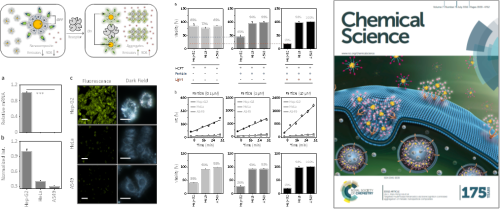Targeted theranostics combines targeted diagnosis and targeted therapy, aiming for early diagnosis, accurate molecular imaging, and precise treatment targeting malignant cells at the right timing and proper dose. Targeted therapy is becoming one of the major modalities of medical treatment (pharmacotherapy) for cancer, which is expected to be more effective than conventional forms of treatments and less harmful to normal cells.
Researchers at Shanghai Institute of Materia Medica(SIMM), CAS, and East China University of Science and Technology(ECUST) have developed a gold glyconanocomposite for the multimodal theranostics of cancer. The nanocomposite is capped with a cyclodextrin layer to which an adamantine-modified fluorescent glycoprobe was introduced by a host-guest supramolecular interaction. The nanocomposite shows a quenched fluorescence because of a Förster Resonance Energy Transfer (FRET) from the fluorophore to the proximal particle. However, the subsequent interaction with a selective protein receptor causes aggregation of the composite, recovering the fluorescence by Metal-Enhanced Fluorescence (MEF) from the distal gold particles to fluorophores within the aggregates. A red-shifted absorbance is also observed for the nanocomposite, leading to an enhanced reactive oxygen species (ROS) production with red-light irradiation. The fact that both knockdown of a transmembrane galactose receptor, ASGPr and competition by free galactose suppressed the fuorescence suggests the ability of the nanocomposite developed for targeted cell imaging by receptor mediated intracellular aggregation. The nanocomposite has also been successfully used for a multimode therapy using its photodynamic ROS production and drug delivery properties targeting the receptor-rich cancer cells.
This research was accomplished under the corporation between Prof. LI Jia & ZANG Yi’s (SIMM) and Prof. CHEN Guo-Rong & HE Xiao-Peng’s (ECUST) groups. As a proof-of-concept, the nanocomposite has proven to work as a receptor-targeting cell imaging and multimode theranostic system, using both the drug carrying and photodynamic properties of the nanocomposite. This research paves the way for the development of a diverse array of fluorogenic, therapeutic nanomaterials based on the diversity of available metallic nanoparticles. The research has been recently published in Chem. Sci. (2016, 7, 4004-4008) as a cover story.
